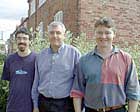

[Rotherham's team]
![]()
the Rotherham's team
 |
the Rotherham's team, left to right: Lee Evans, Steve Fish and Jerry Elford |
Steve Fish: managing director of Rotherham & Sons.
Jerry Elford: industrial modelmaker, currently engaged in the relaunch of Rotherham's millennium
clocks.
Lee Evans: industrial designer and precision engineer at Rotherham's.
The team from Rotherham & Sons -- generally acknowledged as the oldest firm in Coventry, founded in 1750 as a watchmaking firm in Spon Street -- was shown a rare watch (so rare that it is not allowed outside the Herbert Art Gallery & Museum). On it was a portrait of Princess Charlotte and the date 1819. The team had to find out why this watch was made the way it was and where it was manufactured.
Steve was also interested in discovering the origins of Rotherham & Sons. Gerry was keen on establishing a Rotherham connection with prominent Coventry clocks. And Lee wanted to know how innovative Rotherham's had been.
 |
the Rotherham's team watch |
how the team got on
HISTORY ROOM
Steve, Jerry and Lee are looking into the origins of a rare and
valuable watch with a portrait of Princess Charlotte on it, made in 1819. They investigate trademarks in trade directories
to find out which manufacturer used 'VSR', which appears on their
watch. They discover that 'VSR' is a misprint for 'V&R', which
stands for 'Vale & Rotherham'. They look up the life of Princess
Charlotte in the Dictionary of National Biography and find that she died in childbirth in 1817. Looking through
the town records and a newspaper cuttings file, they learn that
Princess Charlotte's husband visited Coventry in the year the
watch was made.
Examining trade directories, partnership agreements, leases and other records, they discover that Samuel Vale established a watchmaking firm in 1747. Over the years, as partners were taken on and left, the firm changed its name: Vale, Howlette & Carr; Vale, Howlette, Carr & Rotherham; Vale & Rotherham; Vale, Kevitt & Rotherham; Vale, Rotherham & Rotherham. In 1776, Samuel Vale leased premises in Spon Street and began a factory system.
They read the 1817 Report from the Committee on the Petitions of Watchmakers of Coventry, which singles out Rotherham's (by description, not by name) for bad practice with their apprentices. This report led to new laws two years later. Leafing through rate books from 1851, a factory plan and a page of workshop rules from 1864 gives them a vivid picture of how the factory operated, how successful it was and how mechanisation helped the firm to survive.
WEAVERS' COTTAGES, OFF SPON STREET
Carl Chinn shows the team the cottages once occupied by ribbon
weavers, who were the main industry in Coventry before watchmaking.
When the weaving trade collapsed, the buildings were adapted for
watchmakers.
SPON STREET
Team goes to Nos. 26-28 where Rotherham's was established in 1874.
HISTORY ROOM
The team now focuses on finding links between prominent Coventry
clocks and Rotherham's. By examining apprenticeship records, they
discover that, in 1831, E T Loseby, who made the works of the Market Hall clock, was apprenticed
to the firm. They also find his patent. When the Market Hall was
dismantled in 1942, the clock movement was stored and then used
in the Godiva clock in Broadgate.
Steve, interested in finding out the overall performance of Rotherham's watches, finds certificates awarding gold medals to the firm, including a gold medal from the 1889 Paris Exhibition.
GODIVA CLOCK
The team go up inside the clock to look at Loseby's movement.